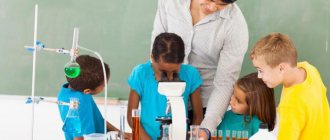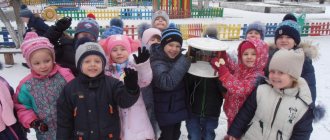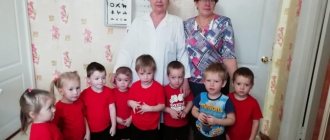Middle group. Junior preschool age. Children 4 - 5 years old
Environmental project "Ecolyats - preschool children" in the middle group Environmental project " Ecolyats - preschool children "
Middle group Justification of the problem.
The presence of global environmental environmental problems is a serious threat to all humanity in the modern world.
Today, the main task for people should be the preservation... Environmental social and educational project in the middle group (from 4 to 5 years old) “Eco-preschool children” Relevance of the Project One of the directions for the development of the state and the unification of a multinational society is the patriotic education of the younger generation. This is one of the priority areas in the Russian education system, contributing to the formation of...
The relevance of the development and implementation of a pedagogical project
From birth, children are surrounded by various phenomena of inanimate nature: on a summer day they see the sun and feel the warm wind; on a winter evening they look in surprise at the moon, the dark sky filled with stars, feel the frost pinching their cheeks... They collect stones, draw on the asphalt with chalk, play with sand and water - objects and phenomena of inanimate nature are part of their life activity, are objects of observation and play. This circumstance makes it possible to systematically and purposefully familiarize preschoolers with the phenomena of inanimate nature. Moreover, it is simply necessary.
In nature, everything is interconnected: plants, animals, soil, rivers, air, etc. are in inextricable unity - living nature cannot do without inanimate nature. The plant exists only because it penetrates the ground with its roots and absorbs moisture and nutrients from it, stretches its stem upward, and turns its leaves toward the sun, absorbing its light and heat. The plant needs air, moisture and warmth; in such favorable conditions it feels good: it grows, blooms, bears fruit and pleases the human eye.
The same can be said about animals: they, like plants, have vital needs, many of which can be satisfied only with the help of inanimate nature. Thus, animals, as part of living nature, have their own special relationships with inanimate nature.
Humans have an even stronger connection with inanimate nature than plants and animals. People need fresh air, for life and farming they need water, but not any water, only clean water - natural or specially purified. Humanity has reached such heights in the development of civilization because it has learned to use natural resources: extract coal, oil, ore, use clay and sand in construction, making household items...
Thus, all phenomena of inanimate nature that surround a preschooler are the subject of a unified system of environmental education.
Understanding the importance of search activity in the development of children’s cognitive activity and their intellectual abilities, I chose children’s experimentation as one of the types of activity. The proverb says: “Tell me and I’ll forget, show me and I’ll remember, let me try and I’ll understand.” Everything is assimilated firmly and for a long time when the child hears, sees and does it himself. This is the basis for the active introduction of children's experimentation into the practice of preschool institutions.
Plan for working with children
September
Project development. Selection of method, literature.
October
Topic: “What kind of water?”
Purpose: To identify the properties of water: transparent, odorless, flows, some substances dissolve in it, has weight, has no color and odor.
Expected result : Children will learn the properties of water such as: transparent, flowing, is a solvent, has no color and odor, and has weight.
Topic: What's in the package?
Goal: Detect air in the surrounding space.
Expected result : Children learn that air occupies all the surrounding space.
November
Topic : Light - heavy.
Purpose: to introduce that objects can be light and heavy. Learn to determine the weight of objects and group objects by weight (light - heavy). Expected result : They will learn to determine the weight of objects and group objects by weight (light - heavy).
Topic: We are magicians.
Goal: Identify objects that interact with a magnet. Expected result : They will become familiar with the properties of a magnet and objects that interact with it.
December
Topic: How to warm your hands?
Goal: Identify the conditions under which objects can warm up (friction, movement; heat conservation). Expected result : They will learn to heat objects using friction, movement and identify the conditions for maintaining heat.
January
Topic: Glass, its qualities and properties.
Goal: Recognize objects made of glass; determine its qualities (surface structure, thickness, transparency) and properties (fragility, melting, thermal conductivity).
Expected result : Get acquainted with glass and its properties. Learn to identify its qualities.
February
Topic: Metal, its qualities and properties.
Goal: Recognize objects made of metal, determine its qualitative characteristics (surface structure, color) and properties (thermal conductivity, malleability, metallic luster).
Expected result : Get acquainted with metal and its properties. Learn to identify its qualities.
Topic: Magic mitten.
Goal : Find out the ability of a magnet to attract certain objects. Expected result : consolidate the properties of a magnet and identify with which objects it interacts.
March
Topic: Rubber, its qualities and properties. Goal: To recognize things made from rubber, to determine its qualities (surface structure, thickness) and properties (density, elasticity, elasticity). Expected result : Get acquainted with rubber and its properties. Learn to identify its qualities.
Topic: What do birds use to build their nests?
Purpose: To identify some features of the lifestyle of birds in the spring. Expected result : They will learn some features of the way of life of birds in the spring.
April
Topic: Plastic, its qualities and properties.
Goal: To recognize things made of plastic, to determine its qualities (surface structure, thickness, color) and properties (density, flexibility, melting, thermal conductivity). Expected result : Get acquainted with plastic and its properties. Learn to identify its qualities.
Topic: Water transparency.
Goal: To generalize “clean water is transparent”, “dirty water is opaque”. Expected result : Get acquainted with the property of water “transparency”, learn to identify clear water.
May
Topic: "Paper lumps."
Goal: To introduce children to a new property of paper - rolling. The teacher teaches children to make lumps of paper, and then use them as a collective applique. Expected result : They will become familiar with a new property of paper - rolling. The teacher teaches children to make lumps out of paper, and then from them into a collective applique.
Long-term plan for the club “The Unexplored is Nearby”
October
Parent meeting on the topic : Let's experiment, learn, create!
Contents : Informing parents that the main advantage of the experimentation method is that it gives children real ideas about the various aspects of the object being studied, about its relationships with other objects and with the environment. During the experiment, the child’s memory is enriched, his thought processes are activated, since the need constantly arises to perform operations of analysis and synthesis, comparison and classification, and generalization.
January
Consultation “Development of observation and curiosity of a preschool child through experimental games at home.” Contents: Informing parents on how to properly ensure the full environmental education of a child of middle preschool age. Continue to introduce games to study the properties of objects and inanimate phenomena that will be used by parents at home.
April
Open game-activity “Journey to the Sand Fairy.”
Project stages
I Preparatory stage
- The teacher determines the topic, goals and objectives, the content of the project, predicting the result.
- Discussion with parents of the project, clarification of the possibilities, funds necessary for the implementation of the project, determination of the content of the activities of all project participants.
II Main stage of the project implementation
- Implementation of a work plan for all types of activities with children.
- Interaction with parents to solve assigned problems.
- Creation of the club “The Unknown is Nearby”.
- Once a quarter, joint “meetings” of the club (parents and children) are held in the form of entertainment, games, activities, leisure, and consultations.
- Creation of an information space (information stand; design of a folder - moving).
- A selection of works of art and educational games on this topic.
III. The final stage
Diagnostics and summarizing work results.
- summing up the work on the project.
- survey of parents on the topic: “What has your child learned?”
- monitoring the quality of children’s mastery of material.
- open lesson - entertainment for parents “What we learned” (based on the results of the project).
- presentation of the project for teachers of preschool educational institutions, a message from the experience of working on the project.
Forms of working with children
Based on conceptual approaches and taking into account the characteristics of children, we have developed and tested a series of developmental activities. The practical significance lies in the use of the developed material in various types and educational areas of children's activities.
The content of the project involves an integrated approach to the development of a child at the emotional, psychophysiological and intellectual levels through familiarity with nature in various types of work with children (for example, observations, work in nature, activities and holidays of an integrated nature, entertainment, experimental activities).
The choice of priority form of work with children depends on seasonality, children’s interest in the proposed activity, their age characteristics, and conditions.
Future perspective
Develop a project “The Unknown is Nearby” for children in the senior and preparatory groups.
Although the most significant thing in the mental development of a child occurs at the early age stage, it is necessary to purposefully engage in experimental activities at the next stages of the personal formation of children.
Continuing the further development of cognitive and creative activity through the involvement of preschoolers in research work, the teacher prepares children for a very difficult stage in their lives - the school years.
MAGAZINE Preschooler.RF
Long-term project “City Defenders from Waste” for the middle group.Project type: creative, informational, educational.
Duration: long-term, 2 months.
Participants: middle school children, parents, teachers.
Problem: environmental protection, an attempt to solve the garbage problem.
Relevance: garbage is an environmental problem in the modern world. Each of us throws out a huge amount of garbage. It is formed in kindergartens, schools, hospitals, residential premises, on the streets, in factories, etc. The problem of garbage has been and remains eternal...
Goal: to help reduce environmental pollution from household waste and develop creativity in making crafts and costumes from waste material.
Objectives: To introduce children to the environmental problem of garbage and find ways to solve it;
Develop the creative abilities of parents and children in making crafts;
To develop children's cognitive interest in environmental issues;
To promote the active involvement of parents in joint activities with the child in family and kindergarten settings.
Expected results:
For children: instilling environmental culture in children; responsible attitude to significant tasks;
development of activity and independence in children; acquiring new knowledge and impressions about the world around us.
For the teacher: increasing professionalism; introduction of new methods in working with children and parents; personal and professional growth; self-realization.
For parents: strengthening relationships between children and parents; self-realization.
Stages:
1. Organizational
The teacher reveals the problem of children's participation in the project. Cause a positive response from parents to an environmental problem.
2. Activity planning:
Educator:
Consultations for parents: “Why do children need to know what ecology is” , “Recycling paper will help save forests” ; memo “Learn to sort waste” .
Conversations with children: “Is garbage good or bad” , “Where does garbage come from” , “Garbage can be useful” .
Didactic and printed board games: Lotto “Sorting the garbage correctly” , “What is the object made of” , “Good-bad” , “Collect beads” , “Wonderful bag” , “Yes-no” .
Experiments: “Acquaintance with the properties of paper, plastic, rubber, glass, metal objects .
Outdoor games: “Air, Earth, Water” , “Take care of nature” , “The fourth odd one” .
Role-playing games: “Forest Patrol” .
GCD (cognitive development):
Conversations: “Clean Planet” , “Take care of nature” .
Green patrol “Clean area of the kindergarten” .
Monitoring the work of the janitor.
Observations “Where does the garbage disappear in kindergarten” .
SCD (social and communicative development):
Reading fiction: Ecological fairy tales: “The Bunny and the Little Bear” , “Masha and the Bear” , “No Place for Garbage” , “The Tale of the Damned Trash” . A. Yashin “Feed the Birds” , Y. Akim “Our Planet” , S. Mikhalkov “Walk” , A. Usachev “Garbage Fantasy” .
ECD (artistic and aesthetic development): collective work on the application “Save the planet from garbage” , drawing “Let’s remove the garbage together” , modeling “Trash cans” , making rattles from waste material: plastic spoons, Kinder surprise eggs, beans, insulating tape.
ECD (physical development): physical education and environmental entertainment “Let's protect nature from garbage .
Children: Learning poems, searching with parents for new knowledge about waste disposal.
Parents: Search for information about waste disposal with your children.
Participation in the creation of works on the topic: “The second life of unnecessary things” , “Unusual costumes” .
3. Final.
Exhibition of crafts “Second life of unnecessary things” .
Carrying out a fashion verdict “Defile of unusual costumes” .
Results of project activities:
During the project, children developed an interest in learning about nature, the problem of environmental pollution, and observation skills. It was very important that parents became an integral part of the project. Thanks to their creativity, enthusiasm and skillful hands, what we often discussed with the children came true: how to help the city? What can be made from garbage, from what we no longer need and will not be useful in life?
Our project is a call for everyone. They say that it is clean not where they clean, but where they don’t litter.
| Next > |





